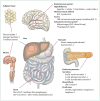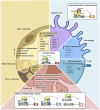Team players in the pathogenesis of metabolic dysfunctions-associated steatotic liver disease: The basis of development of pharmacotherapy
- PMID: 39220834
- PMCID: PMC11362842
- DOI: 10.4291/wjgp.v15.i4.93606
Team players in the pathogenesis of metabolic dysfunctions-associated steatotic liver disease: The basis of development of pharmacotherapy
Abstract
Nutrient metabolism is regulated by several factors. Social determinants of health with or without genetics are the primary regulator of metabolism, and an unhealthy lifestyle affects all modulators and mediators, leading to the adaptation and finally to the exhaustion of cellular functions. Hepatic steatosis is defined by presence of fat in more than 5% of hepatocytes. In hepatocytes, fat is stored as triglycerides in lipid droplet. Hepatic steatosis results from a combination of multiple intracellular processes. In a healthy individual nutrient metabolism is regulated at several steps. It ranges from the selection of nutrients in a grocery store to the last step of consumption of ATP as an energy or as a building block of a cell as structural component. Several hormones, peptides, and genes have been described that participate in nutrient metabolism. Several enzymes participate in each nutrient metabolism as described above from ingestion to generation of ATP. As of now several publications have revealed very intricate regulation of nutrient metabolism, where most of the regulatory factors are tied to each other bidirectionally, making it difficult to comprehend chronological sequence of events. Insulin hormone is the primary regulator of all nutrients' metabolism both in prandial and fasting states. Insulin exerts its effects directly and indirectly on enzymes involved in the three main cellular function processes; metabolic, inflammation and repair, and cell growth and regeneration. Final regulators that control the enzymatic functions through stimulation or suppression of a cell are nuclear receptors in especially farnesoid X receptor and peroxisome proliferator-activated receptor/RXR ligands, adiponectin, leptin, and adiponutrin. Insulin hormone has direct effect on these final modulators. Whereas blood glucose level, serum lipids, incretin hormones, bile acids in conjunction with microbiota are intermediary modulators which are controlled by lifestyle. The purpose of this review is to overview the key players in the pathogenesis of metabolic dysfunction-associated steatotic liver disease (MASLD) that help us understand the disease natural course, risk stratification, role of lifestyle and pharmacotherapy in each individual patient with MASLD to achieve personalized care and target the practice of precision medicine. PubMed and Google Scholar databases were used to identify publication related to metabolism of carbohydrate and fat in states of health and disease states; MASLD, cardiovascular disease and cancer. More than 1000 publications including original research and review papers were reviewed.
Keywords: Adiponectin; Diabetes; Dyslipidemia; Farnesoid X receptor; Genetics; Glucagon-like peptide-1; Insulin; Metabolic dysfunctions-associated steatotic liver disease; Obesity; PNPLA3; Pathogenesis; Peroxisome proliferator-activated receptor; TM6SF2; Visceral adiposity.
©The Author(s) 2024. Published by Baishideng Publishing Group Inc. All rights reserved.
Conflict of interest statement
Conflict-of-interest statement: All the authors report no relevant conflicts of interest for this article.
Figures









Similar articles
-
Metabolic-Dysfunction-Associated Steatotic Liver Disease-Its Pathophysiology, Association with Atherosclerosis and Cardiovascular Disease, and Treatments.Int J Mol Sci. 2023 Oct 23;24(20):15473. doi: 10.3390/ijms242015473. Int J Mol Sci. 2023. PMID: 37895151 Free PMC article. Review.
-
Comparison of wild-type and high-risk PNPLA3 variants in a human biomimetic liver microphysiology system for metabolic dysfunction-associated steatotic liver disease precision therapy.Front Cell Dev Biol. 2024 Sep 11;12:1423936. doi: 10.3389/fcell.2024.1423936. eCollection 2024. Front Cell Dev Biol. 2024. PMID: 39324073 Free PMC article.
-
Metabolic dysfunction-associated steatotic liver disease heterogeneity: Need of subtyping.World J Gastrointest Pathophysiol. 2024 May 24;15(2):92791. doi: 10.4291/wjgp.v15.i2.92791. World J Gastrointest Pathophysiol. 2024. PMID: 38845820 Free PMC article. Review.
-
Impact of Peroxisome Proliferator-Activated Receptor Agonists on Myosteatosis in the Context of Metabolic Dysfunction-Associated Steatotic Liver Disease.Discov Med. 2024 Jun;36(185):1139-1153. doi: 10.24976/Discov.Med.202436185.104. Discov Med. 2024. PMID: 38926100 Review.
-
Cooperation of liver cells in health and disease.Adv Anat Embryol Cell Biol. 2001;161:III-XIII, 1-151. doi: 10.1007/978-3-642-56553-3. Adv Anat Embryol Cell Biol. 2001. PMID: 11729749 Review.
Cited by
-
Pharmacological Mechanisms of Bile Acids Targeting the Farnesoid X Receptor.Int J Mol Sci. 2024 Dec 20;25(24):13656. doi: 10.3390/ijms252413656. Int J Mol Sci. 2024. PMID: 39769418 Free PMC article.
-
Interaction Between Periodontitis and MASLD: Pathophysiological Associations and Possibilities of Prevention and Therapy.Biomedicines. 2025 May 30;13(6):1346. doi: 10.3390/biomedicines13061346. Biomedicines. 2025. PMID: 40564062 Free PMC article. Review.
References
-
- Kotronen A, Seppänen-Laakso T, Westerbacka J, Kiviluoto T, Arola J, Ruskeepää AL, Oresic M, Yki-Järvinen H. Hepatic stearoyl-CoA desaturase (SCD)-1 activity and diacylglycerol but not ceramide concentrations are increased in the nonalcoholic human fatty liver. Diabetes. 2009;58:203–208. - PMC - PubMed
-
- Kotronen A, Velagapudi VR, Yetukuri L, Westerbacka J, Bergholm R, Ekroos K, Makkonen J, Taskinen MR, Oresic M, Yki-Järvinen H. Serum saturated fatty acids containing triacylglycerols are better markers of insulin resistance than total serum triacylglycerol concentrations. Diabetologia. 2009;52:684–690. - PubMed
-
- Diraison F, Moulin P, Beylot M. Contribution of hepatic de novo lipogenesis and reesterification of plasma non esterified fatty acids to plasma triglyceride synthesis during non-alcoholic fatty liver disease. Diabetes Metab. 2003;29:478–485. - PubMed
-
- Diraison F, Pachiaudi C, Beylot M. Measuring lipogenesis and cholesterol synthesis in humans with deuterated water: use of simple gas chromatographic/mass spectrometric techniques. J Mass Spectrom. 1997;32:81–86. - PubMed
Publication types
LinkOut - more resources
Full Text Sources
Research Materials

